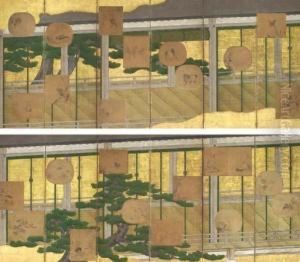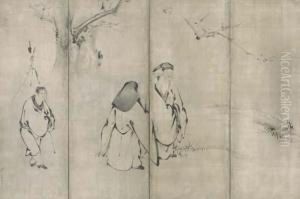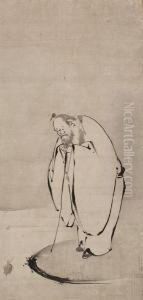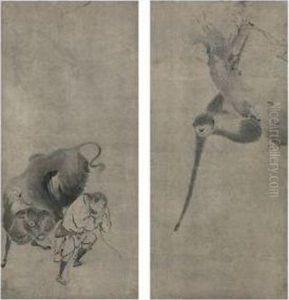Kaiho Yusho Paintings
Kaiho Yusho, born in 1533, was a distinguished Japanese painter whose work significantly contributed to the development of the Momoyama period (1573–1603) art. Unlike many of his contemporaries who hailed from notable art families or were aligned with specific temples or courtly patrons from an early age, Yusho’s origins and early life remain less documented, giving his emergence in the art world a somewhat enigmatic quality. What is known is that he was originally from Omi (present-day Shiga Prefecture) and later moved to Kyoto, where he would establish his career and leave a lasting legacy.
Yusho's art is characterized by its bold yet nuanced use of ink and color, as well as its integration of both Chinese and Japanese aesthetic principles. His large-scale fusuma (sliding door) and byobu (folding screen) paintings are particularly celebrated for their dynamic compositions and vivid depiction of nature, including majestic landscapes and vigorous waves, elements that would profoundly influence the Rinpa school and other subsequent art movements in Japan. His style, while rooted in the traditions of the Kano school—which dominated Japanese painting with its blend of Chinese-inspired themes and Japanese sensibilities—also displayed a unique lyrical quality and an innovative approach to spatial composition.
Despite the prominence of his art during the Momoyama period, specific details about Yusho's life, including his training and influences, are shrouded in mystery. However, it is generally believed that he was influenced by the work of Chinese painters of the Ming Dynasty, as well as by earlier Japanese artists. Throughout his career, Yusho received commissions from influential daimyo (feudal lords) and religious institutions, which enabled him to work on a grand scale and further develop his distinctive style.
Yusho continued to paint well into his later years, with some sources suggesting that he remained active as an artist until his death in 1615. His legacy endured beyond his lifetime, inspiring future generations of artists and contributing to the evolution of Japanese painting. Today, Kaiho Yusho is remembered as a master of the Momoyama period, whose artworks offer a window into the rich cultural and artistic landscape of late 16th to early 17th century Japan.



